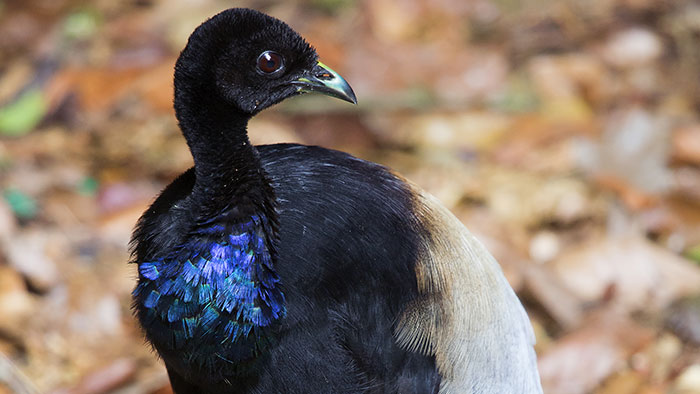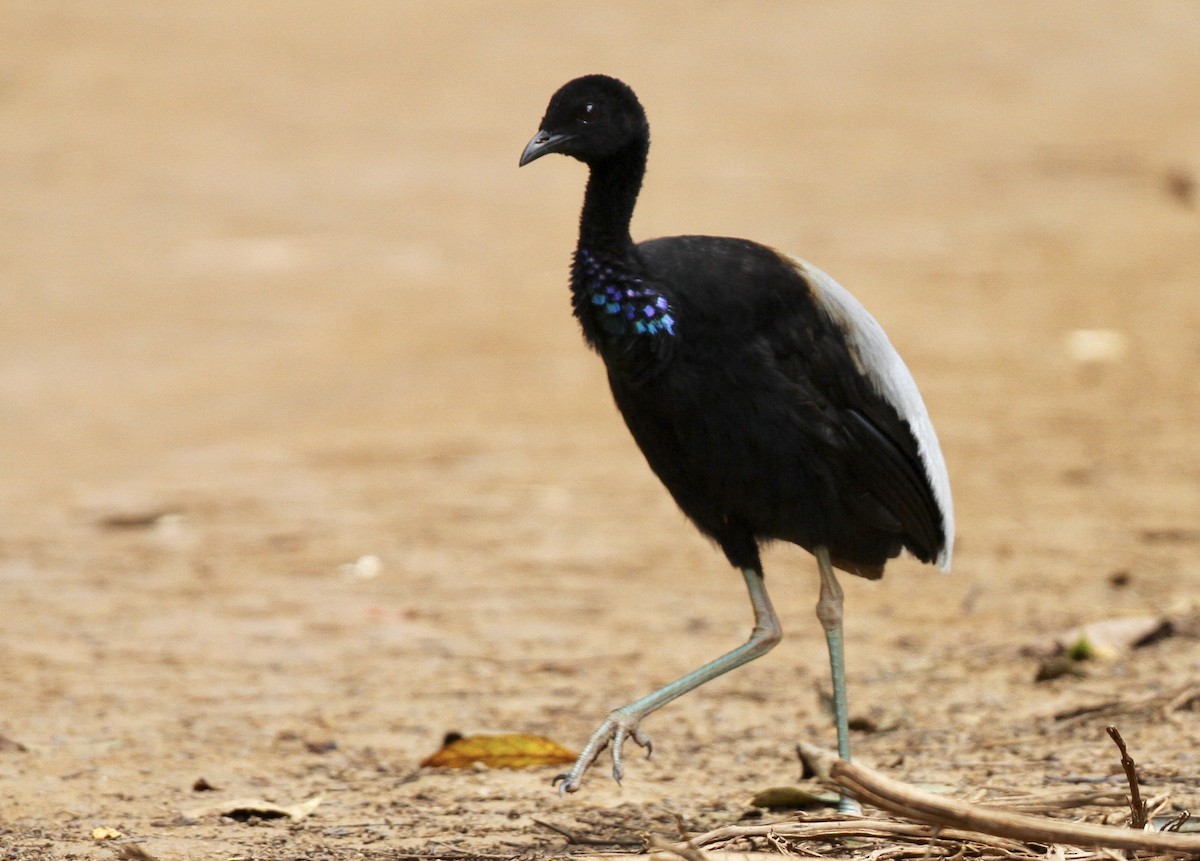Dogs are commonly used as guards but in some parts of Guyana an interesting choice might surprise you – Meet The Feisty Grey Winged Trumpeter.
The Grey-winged Trumpeter (Psophia crepitans) is a member of a small family of birds, the Psophiidae, which occur only in the Amazon basin in tropical South America, including here in Guyana.

Grey-winged Trumpeter | http://mnzoo.org/blog/animals/grey-winged-trumpeter/
Description Of The Grey-Winged Trumpeter
The adult male has velvety black feathers on head, neck, upper back and underparts. You can see violet and green gloss on some feathers on lower fore neck. Inner wing feathers are grey, covering lower back and short tail. Pale buffy tinge on back, between black and grey plumage.
Head and neck are black, covered with very short feathers. They are very dense and have velvet appearance. Pointed bill is pale yellowish to pale-blue-grey. Eyes are dark brown. Legs and feet are bluish-grey.
Both sexes are similar, with male slightly larger than female.
There are three trumpeter species, all in the genus Psophia, the other two being the Pale-winged Trumpeter and the Dark-winged Trumpeter. It is a terrestrial bird, with hunched back and long neck held against the breast.
It is 48-56 cm long and 1.3 kg in weight.
The Grey-winged Trumpeter song is a low humming, but its call, as its name suggests, is a very loud Jeek or honking Tzaak. When alarmed, it gives harsh grunts. Grey-winged Trumpeter can be noisy and vocal at night, or when in group.
Habitats Of The Grey-Winged Trumpeter
Grey-winged Trumpeter lives in wet tropical forests. It feeds on the forest floor and it is often found deep in the forest where it hides. It can be found at up to 500 metres of elevation
Behavior Of The Grey-Winged Trumpeter
Grey-winged Trumpeter is gregarious (social) and often seen in groups of up to 20 birds. They forage on the forest floor, or rest together. This species is mainly territorial but they roost in trees and are often active by night.
Grey-winged Trumpeter is wary, but this species can become tame as pet. It usually “sounds the alarm” by loud trumpeting calls is there are disturbances by day or night. This bird is also a good snake hunter.
They are usually seen walking, searching for ripe fruits on the ground. When disturbed, it flies laboriously into branches. They are heavily hunted.
It is kept as a pet by Amerindians, since it is easily tamed, hunts snakes, and is a very efficient sentinel, with its unique alarm call.
Courtship displays occur in clearings where Grey-winged Trumpeters gather in large groups, and perform elaborate and noisy crane-like dances. Birds strut, leap and sometimes somersault. Males often open briefly the wings and flap them 2 or 3 times, while rapidly bows forwards with head and neck towards the ground. During these displays, birds walk, follow or circle each other, while flapping wings. These displays can be performed by both sexes, but mainly by males, and with greater intensity. Courtship feeding from male to female occurs before copulation.
When intruders enter the area, fights occur with kicking and pecking, until opponents leave the territory. These groups include usually a dominant female and three dominant males, and their young.
Reproduction Of The Grey-Winged Trumpeter
Grey-winged Trumpeter can nest in small colonies.Their Nest is situated in a hole in tree, at about 4 to 13 metres above the ground. Some plant materials can be added, such as twigs and leaves. But their nest can also be a simple scrape on the ground.
Breeding season occurs during the rainy season, from December to June.
Dominant female will mate with the three dominant males.
Female lays 2 to 3 white eggs. Incubation lasts about 28 days, shared by all adults of the group. Young leave the nest relatively soon after hatching. They are highly precocial, but their growing is slow. They need about 50 days to reach half weight of the adults. They have brown and black stripes in plumage as camouflage. They are fed by adults of the group during several weeks. They roost close to the ground before to fly, and are often preyed upon by snakes.
Diet Of The Grey-Winged Trumpeter
They feeds mainly on ripe fruits taken on forest floor or in small plants. They prefer soft fruits with thin skins. This species also consumes large numbers of insects such as beetles, ants and termites. Occasionally, they can eat small snakes.
Some Facts About The Grey-Winged Trumpeter
- The trumpeter’s name probably originates from the deep low sounds they use to communicate. One sound is used as a flocking call while the other is a threatening call.
- Gray-winged trumpeters are non-migratory terrestrial birds.
- These birds are polyandrous, meaning that the females may mate with more than one male.
- Trumpeters rarely fly, but can run fast if necessary.
Watch This: The Grey-winged Trumpeter Sings
About The Grey-Winged Trumpeter
They are gregarious and can be found in countries such as Brazil, Peru and Guyana. They don’t usually fly but they can run fast when necessary.
The Grey-Winged Trumpeter are dense and have velvety appearance. They are truly a sight to behold.
Article References:
- https://en.m.wikipedia.org/wiki/Grey-winged_trumpeter
- https://seaworld.org/animals/facts/birds/gray-winged-trumpeter/







